Abstract
Previous research on financial contagion has mostly looked at volatility spillovers using static or fixed parameter models. These models don’t always take into account how inter-market links change and depend on frequency during big crises. This study fills in that gap by looking at how changes in volatility in the G20 equity markets affected four big global events: the global financial crisis of 2008, the European debt crisis, the COVID-19 pandemic, and the Russia-Ukraine war. The study uses a Time-Varying Parameter Vector Autoregression (TVP VAR) framework along with the Baruník-Křehlík frequency domain spillover measure to look at how connectedness changes over short-term (1–5 days) and long-term (5–Inf days) time periods. The results show that systemic connectedness changes a lot during crises. For example, the Total Connectedness Index (TCI) was 24–25 percent during the GFC and EDC, 34 percent during COVID-19, and a huge jump to 60 percent during the Russia-Ukraine war. During the global financial crisis and the war between Russia and Ukraine, the US constantly emerged as the largest transmitter. During the European debt crisis, on the other hand, emerging markets like Turkey, South Africa, and Japan acted as net transmitters. During all crisis times, short-term spillovers are the most common. This shows how important high-frequency volatility transmission is. This study is different from others because it uses both time-varying and frequency domain views. This gives us a better idea of how crises change the way global finances are linked. The results are very important for policymakers and investors because they show how important it is to coordinate risk management, improve market safety, and make systemic stress testing better in a global financial world.
1. Introduction
Financial markets are intricately linked, and fluctuations in one market may rapidly propagate across borders, influencing neighboring countries and markets in a process termed volatility spillover (; ). As capital flows and trade continue to globalize, the G20 nations, accounting for more than 85% of global GDP, have emerged as crucial influencers in global financial dynamics (; ). Comprehending the manifestation of volatility spillovers across these countries is essential, particularly during periods of severe economic turmoil and geopolitical instability. In the last twenty years, the world has experienced significant shocks, particularly the Global Financial Crisis of 2008, the European Sovereign Debt Crisis, the COVID-19 pandemic, and the ongoing Russia-Ukraine War, all of which have profoundly impacted global financial markets (; ; ; ).
The 2008 Global Financial Crisis stemmed from the failure of the subprime mortgage market in the United States, rapidly evolving into a worldwide financial catastrophe (; ). This crisis interrupted global credit flows, diminished investor confidence, and markedly heightened financial market volatility (; ). Research indicates that throughout this timeframe, volatility spillovers across G20 stock markets accelerated, with developed nations assuming a more prominent role in shock transmission (; ). Subsequently, the European Debt Crisis from 2010 to 2012, instigated by excessive sovereign borrowing and structural disparities, especially in Greece, Portugal, Spain, and Italy, rekindled concerns of contagion inside the Eurozone (; ). This crisis resulted in the decoupling and recoupling of volatility transmission patterns throughout the G20, especially between European and non-European markets (; ).
The emergence of COVID-19 in late 2019 initiated a new kind of disruption, characterized by pervasive uncertainty, lockdowns, and supply chain interruptions (; ; ). Financial markets exhibited extraordinary volatility, characterized by abrupt declines and swift recoveries driven by pandemic-related policy interventions (; ). Studies reveal that during COVID-19, the trajectory and intensity of volatility spillovers fluctuated regularly, with developing markets exhibiting heightened sensitivity to global shocks (). Furthermore, the variability in policy responses across the G20—spanning from assertive monetary easing to fiscal stimulus—further affected volatility transmission (; ).
The Russia-Ukraine War, initiated in February 2022, has introduced additional layers of geopolitical and energy-related insecurity. The conflict impacted international commodity markets, particularly oil and food supply, resulting in repercussions across financial and currency markets (). The G20 nations, owing to their diverse economic connections with Russia and Ukraine, have seen asymmetrical volatility spillovers (; ). European markets, owing to their energy reliance on Russia, exhibited more volatility compared to more insulated economies such as Australia or Brazil ().
This research aims to analyze the type, direction, and degree of volatility spillovers across G20 stock markets throughout these four pivotal periods. Although previous research has examined spillovers during specific crises (e.g., ; ), a comparative assessment including all significant crises of the past two decades is still scarce. Moreover, the structural disruptions caused by these occurrences need a dynamic framework for the analysis of volatility transmission (; ). This study seeks to address this deficiency by utilizing a robust econometric model, specifically the TVP VAR BK, which captures both time-varying and frequency-dependent spillovers, thus enhancing the literature on systemic risk, portfolio diversification, and macro-financial stability (; ; ).
Despite extensive research on volatility spillovers during individual crisis periods, there remains a significant gap in the literature regarding a comprehensive and comparative analysis of spillover dynamics across multiple major crises using advanced time-varying methodologies (; ). Most existing studies focus on specific crisis periods or employ static methodologies that fail to capture the evolving nature of financial market interconnections (; ). The existing literature has several limitations that this research addresses. First, many studies rely on rolling window approaches that suffer from arbitrary parameter choices and loss of observations. Second, most research focuses on time-domain analysis, missing the frequency-specific characteristics of spillover transmission (). Third, comparative analysis across multiple crisis periods using consistent methodological frameworks remains limited. Furthermore, while individual studies have examined volatility spillovers during the global financial crisis, European debt crisis, COVID-19 pandemic, and Russia-Ukraine conflict, no comprehensive study has systematically compared spillover patterns across all these major crises using the advanced TVP-VAR Barunik-Krehlik methodology.
The remainder of the paper is structured as follows: Section 2 reviews the related literature on volatility spillovers and market interconnectedness during crisis periods. Section 3 details the data sources, sample period, and econometric methodologies employed, including the rationale for frequency-domain analysis. Section 4 presents and analyzes the empirical results, highlighting total and directional spillovers as well as frequency decomposition across crisis events. Section 5 concludes the paper, summarizes the main contributions, and suggests avenues for future research in the evolving landscape of global financial integration. Section 6 discusses the practical implications for policymakers, investors, and regulators, especially regarding risk management, portfolio diversification, and systemic risk monitoring.
2. Literature Review
In this section, we have discussed the existing body of literature on volatility spillover among international markets. Numerous studies have previously examined how different crises, such as economic crisis, climate risks, COVID crisis, geopolitical risks, etc., have affected the volatility spillover for market and sectoral indices (; ; ; ). Volatility spillovers refer to the effect that the occurrence of an event in one market may have on the volatility of other markets (). The transmission of crises resulting from economic interconnectedness through real and financial linkages causes volatility spillover (). Other factors that contribute to the spread of crises include market imperfections or the activities of foreign investors (). () assert that in a heterogeneous market, different types of traders or investors exhibit distinct behaviours and contribute to the volatility of different time resolutions. They concluded that long-term volatility is a stronger predictor of short-term volatility and that investors with varying time horizons have unequal information flow. () showed that markets with a high number of cross-listings or those that are geographically and economically close to each other influence their neighboring markets. According to (), there was a substantial spillover effect and interdependence among China’s three stock markets.
Furthermore, several scholars argued that the appearance and interconnectedness of volatility and illiquidity in equity markets worldwide appear to have been significantly influenced by the US market and the global financial crisis (; ). According to (), the stock market’s diverse range of participants, each with their own short-term or long-term goals, may cause the time-domain spillover across various frequencies to be uneven. In both the short and long term, () discovered strong transmission of unidirectional shock spillovers from the US stock market to the Japanese and Asian emerging stock markets. They added that there are significant bidirectional volatility spillovers between the US and Asian markets because of the Asian financial crisis. Similarly, during the US subprime financial crisis, they discovered notable bidirectional shock spillovers between the Asian emerging markets and the Japanese market. According to (), there were significant spillover effects in the US markets for the period prior to 1997, the dot-com bubble collapse from 2000 to 2002, the subprime mortgage crisis, and the bankruptcy of Lehman Brothers from 2007 to 2008. Additionally, they claimed that strong net spillover is caused by investor attitude, such as an increase in the fear index. () asserts that the US market facilitates the diffusion of information that improves other stock markets. However, depending on the other circumstances, such as the dissemination of information about monetary policy, personal income, or the unemployment rate, the impact of US spillovers differs. Also, () discovered that the volatility index (VIX)change had an impact on the cross-sectional returns of different stock types based on market capitalisation, with large-cap companies being more strongly impacted than others. (), (), (), (), (), and () are just a few of the several studies that have found significant and noteworthy spillovers of cross-market volatility using GARCH, VAR, or MEM. Additionally, several researchers have previously used the methodology of () and () to find volatility spillover among various bonds, stocks, and commodities markets, including (), (), (), (), ().
(), using the methodology of (; ) and (), demonstrated that the geopolitical risk of the COVID-19 pandemic and the conflict in Ukraine caused volatility spillover from the US and developed European stock markets to the Asia-Pacific and emerging European stock markets. () and () indicated a significant effect of climate disasters on Chinese stock market volatility and cryptocurrency liquidity spillover effects. () using the TVPVAR-DY model stated that climate risk suppresses China’s trade policy uncertainty, increases geopolitical risk, risk aversion, and climate risk concern, resulting in stock market risk spillovers. () applied advanced wavelet analysis and causality methods and found that both the climate risks and transition risk lead to changes in investors’ expectations and have strong associations with volatility in energy stock markets. () examined time-varying volatility spillovers between energy and stock markets because of the global financial crisis of 2008 and the ongoing COVID-19 pandemic crisis using a generalised vector autoregressive paradigm. Both crises exhibited significant distinctions even if they have many commonalities, including economic decline, uncertainty, and the responses of monetary and fiscal authorities. They stated that the COVID-19 pandemic crisis saw a significant increase in volatility spillovers between the energy and stock markets, surpassing the global financial crisis of 2007–2008.
() studied the spillover impact between different stock categories and discovered that there are different short- and long-term spillover effects among financial variables due to variations in shock frequency responses. () used Mann-Whitney tests and traditional t-tests to assess the impact of COVID-19 on daily stock market returns and discovered a negative spillover effect on stock market returns. Further, (), using GARCH and GJR-GARCH models, found that COVID-19 has caused the primary G7 stock to experience more stock market volatility. They claimed that the GARCH effect estimates were higher than the ARCH effect estimates, indicating that the current levels of volatility will continue to have an influence for a longer period of time.
In an inter-asset setting, () examined the frequency domain connectivity between gold, Islamic bonds (Sukuk), and Islamic equity. They discovered that there was low short-term volatility spillover between gold and Islamic assets. () discovered that the global financial crisis of 2008 demonstrated the interconnectedness among different international markets and their significant influence on the global economic system. In their study, they exhibited that short-term transitory and long-term fundamental factors were equally affected by the high level of volatility in seven commodity markets generated by the risk stemming from the financial crisis. They found that although changes in oil prices were explained by the financial system, the financial sector was only marginally affected by the oil shock. () examined the type of spillover in the temporal and frequency domains for four global asset classes: stocks, sovereign bonds, currency, and credit default swaps (CDS). They argued that whereas equities and CDS markets were net volatility transmitters, volatility spillover among the four asset classes was more pronounced in the short term. () found asymmetric volatility spillover among 21 highest capitalization equities from different sectors using a vector autoregressive framework. Also, Crude oil prices, US stock prices, clean energy companies, and some significant financial variables, such as the VIX, the yield on US Treasury 10-year bonds, and the treasury yield VIX, all experienced volatility spillover (). () stated that price fluctuations were most noticeable during the short term, but the effects subsided over time.
In conclusion, increased uncertainty and crisis events like the global crisis of 2007–2009, the COVID-19 crisis, the conflict between Russia and Ukraine, etc., necessitate regular and proactive measures to study the relationship between the various crises and systemic risk caused by them, affecting various financial markets or economies.
3. Research Methodology
We apply the TVP VAR model proposed by (), which avoids the issues of loss of sample information and sensitivity outliers caused by a setting rolling window. The TVP VAR model can be written as
where is an dimensional vector, is an dimensional vector, is an matrix of dimensional time varying coefficients that follows a random walk model, is an dimensional perturbation vector, and represents all available information at time.
To calculate the generalized forecast error variance decomposition (GFEVD), we transform the model in Equation (1) into a vector moving average (VMA) to represent
where is an dimensional coefficient matrix.
BK Spillover Index
We further use the generalized decomposition spectrum defined by () to construct the BK spillover index in the frequency domain. First, based on the frequency response function , the spectral density of at frequency can be defined as
where is obtained by performing the Fourier transform of , is the parameter that describes the specific distribution of the variance of over the frequency , which is the key parameter for understanding the frequency dynamics.
The generalized causal spectrum can be defined as:
where denotes the fraction of the spectrum of variable z at a given frequency d that is caused by the shock of variable a. Because the denominator of the above equation is the spectrum of variable z at a given frequency d, can be interpreted as a causal relationship within frequencies.
The following further introduces the frequency share of the variable as a weighting function:
denotes the power of variable z at a given frequency. Then, the generalized variance decomposition over the frequency band c is defined as
where and under and are equal in the time domain. can be further normalized as
measures the level of spillover from variable z to variable a on the frequency c. The spillover index on frequency band c is
The spillover index received by variable z from all other variables a can be expressed as
Similarly, the spillover index of variable z to all other variables a can be expressed as
The net spillover index of variable z to all variables a is then equal to
For the empirical investigation, daily data on G20 stock markets except the European Union (it is an international regional organization in Europe which includes major countries such as Germany, France, etc., which are often treated as separate markets) (). were downloaded from the Bloomberg database. Table 1 displays the stock indices of G20 nations. This study covers four major crisis periods, i.e., Panel 1 is the European debt crisis (EDC) with a starting date of 8 December 2010 to 31 December 2012 (). Panel 2 is the global financial crisis of 2008, starting from 9 October 2007 to 30 June 2009 (). Panel 3 is the COVID-19 pandemic, which covers the period 31 January 2020 to 31 December 2021 (). Panel 4 is the Russia-Ukraine war, which covers from 24 February 2022 to 10 February 2023 ().

Table 1.
G20 Nations, along with their stock market indices.
Logarithmic returns were calculated for daily stocks for all the selected countries, which is given in Equation (12).
where is the price of stock i at time t and is the price of stock i at time t − 1.
The Global Vector Autoregressive (GVAR) method, which was first suggested by (), is a powerful way to look at how different economies are linked and how they affect each other (). However, this study used a method called time varying parameter VAR (TVP VAR) with the Barunik-Krehlik (BK) frequency domain spillover index, which is very different from the normal and regime switching GVAR approaches. The TVP VAR framework lets model parameters change constantly over time, capturing changing dynamics and heterogeneity in relationships between markets, which is especially important during times of crisis. When combined with the BK frequency decomposition, the method provides detailed insights into the temporal and frequency-specific nature of volatility spillovers, enabling the separation of short and long-term transmission pathways.
While the GVAR model is great at modeling large-scale cross-sectional and global links and can adapt to changing regimes, standard models usually assume that parameters stay the same within each regime and focus on effects that happen between countries or regions. The TVP VAR BK method clearly shows how parameters change at each point in time. This makes it easier to look at systemic risk and contagion when world conditions are changing quickly.
4. Empirical Result
This section analyzes the volatility spillover patterns among G20 nations using the Time-Varying Parameter Vector Autoregressive (TVP-VAR) model with frequency decomposition, as introduced by (). This analysis encompasses four significant global crises, namely the GFC 2008, the EDC, the COVID-19 pandemic, and the Russia-Ukraine war, providing a thorough temporal and spectral examination of financial interconnectedness. The model facilitates a detailed analysis of market responses by categorizing spillovers into short-term and long-term components, allowing for the exploration of their evolution across various frequencies and crisis episodes. The findings are presented using the TCI and net spillover metrics, enabling a comparative analysis of each country’s function as a transmitter or recipient of volatility over time. This section presents findings and emphasizes significant changes in contagion patterns across each crisis period.
Table 2 describes the descriptive statistics of G20 nations during the four major crisis periods, namely the Russia-Ukraine crisis, the COVID-19 pandemic, the GFC, and the EDC. Throughout the Russia-Ukraine War, the majority of nations experienced modest yet predominantly favorable mean returns, signifying slight market resilience. Nevertheless, rising economies like Russia, Argentina, and Turkey exhibited considerable volatility and negative skewness, indicating heightened uncertainty and downside risk. Increased kurtosis in nations such as India and Turkey signifies fat-tailed distributions, implying the potential for severe returns. The COVID-19 Pandemic caused significant volatility in both developed and emerging markets. Negative skewness and elevated kurtosis in numerous countries, particularly in Russia and India, indicate substantial downside risks and recurrent extreme return occurrences. Notwithstanding these risks, average returns were somewhat positive for numerous industrialized nations, signifying a modest rebound amidst instability. The Global Financial Crisis of 2008 exerted the most profound and coordinated global effects. Almost all nations encountered adverse mean returns and increased standard deviations, particularly in Argentina, Brazil, and Germany. The pervasive negative skewness and elevated kurtosis in nations such as Russia and India indicate a prevalent propensity for significant negative shocks and substantial tail risk throughout this timeframe.

Table 2.
Descriptive Statistics during crisis periods.
Based on the () methodology, Table 3 presents the return spillover at 1–5 (short-term) and 5–Inf (long-term) frequencies during the European debt crisis (EDC). “TO” shows the extent to which each country transmits volatility shocks to other countries, whereas the “FROM” column reveals the degree to which each country receives volatility spillover from others. The “NET” shows the difference between the “TO” row and the “FROM” column, representing a country that is a net transmitter (positive values) or net receiver (negative) of volatility shocks, respectively. Moreover, the total connectedness index (TCI) is also reported, indicating how integrated the markets were during the crisis period. The TCI value of 23.98% (short term) implies that during the EDC, approximately one-quarter of the volatility in G20 markets was driven by cross-country shocks, indicating moderate financial integration and spillover effects among these economies. Thus, the remaining 76.02% of the variation is explained by own-country effects, i.e., internal market dynamics. Conversely, the TCI value decreases to 3.44% in the long term, implying a low degree of financial integration at 5–Inf frequency. Figure 1 shows the connectivity between the G20 nations across varied sub-periods i.e., short term, long-term, and full period. Figure 2 and Figure 3 show the “To, From, and net spillovers,” respectively. Figure 4 shows TCI across varied frequencies.

Table 3.
BK results during EDC across varied frequencies.
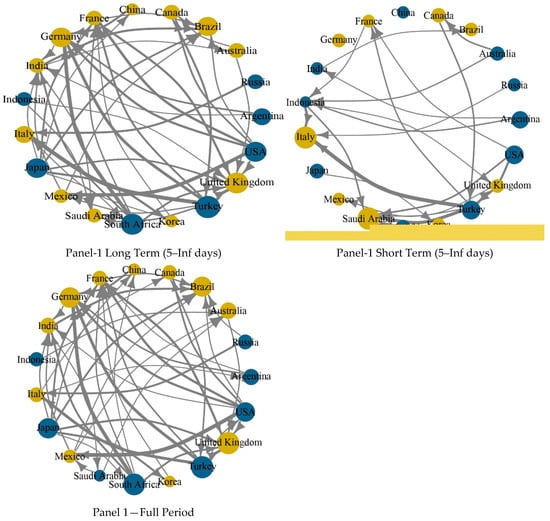
Figure 1.
Frequency spillover based on Barunik Krehlik (BK) during EDC in Short term (1–5), Long term (5–Inf), and Full period.
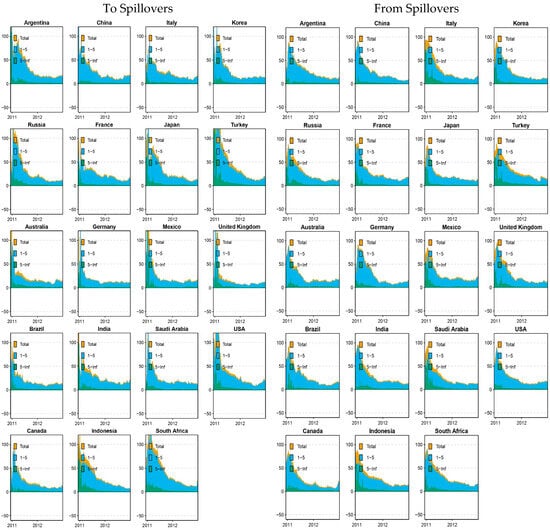
Figure 2.
Transmission of the volatility spillover “to spillover” (transmitter) and “from transmitter” (receiver) during the EDC crisis. Green color denotes the Long term (5–Inf), blue color denotes the short run (1–5), and yellow color denotes the total period (Panel 1).

Figure 3.
Net Spillover during EDC (Panel 1).
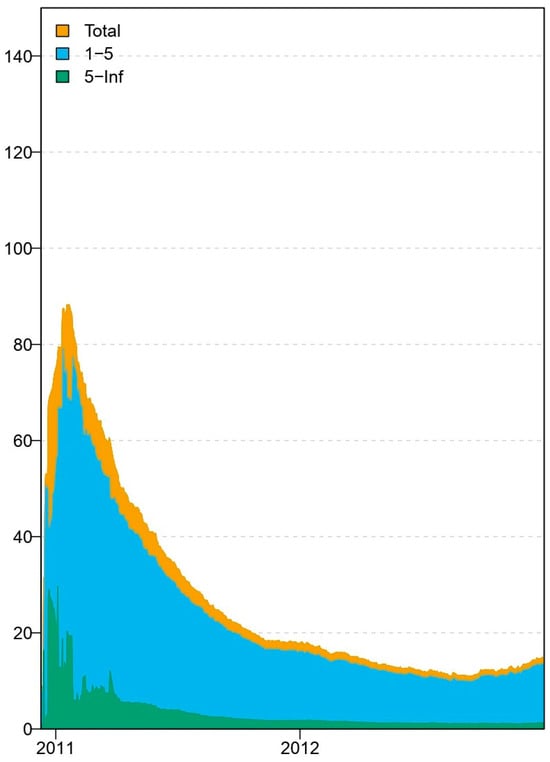
Figure 4.
Frequency spillover based on Barunik Krehlik (BK) during EDC (Panel 1) in short term (1–5), Long Term (5–Inf), and Full period.
Moreover, the empirical results reveal that Brazil (7.97%), India (4%), Australia (4.61%), Germany (8.41%), and United Kingdom (9.89%) emerged as the primary recipients of volatility spillover across varied frequencies, except Australia, and India, which became net transmitters of volatility spillovers in the long run (5 and above) which reflects their growing influence in regional networks and structural reforms that strengthened market resilience (). Whereas Brazil, India, and the UK are major emerging and developed markets with substantial FPI exposure, which increases sensitivity to global shocks. Cross-border liquidity mismatches and dependence on foreign currency-denominated assets amplify volatility reception during stress events (). Also, during 1–5 (short-term) frequency, Japan (8.28%), Turkey (10.05%), South Africa (9.7%), and the USA (7.58%) emerged as the net transmitter of shocks. Japan, Turkey, South Africa, and the USA became net transmitters due to their roles as global financial hubs and high-frequency trading activity. Moreover, the US dollar’s dominance and Japan’s liquidity provisions during crises exacerbated spillovers (). On the contrary, Italy (3.06%) and Saudi Arabia (3.14%) emerged as the primary recipients of volatility spillover in the long run, whereas the USA (2.12%), Turkey (2.13%), and Argentina (1.73%) emerged as the primary transmitters of shocks. Italy and Saudi Arabia are net recipients due to lower financial integration and sectoral vulnerabilities (e.g., Italy’s banking sector, Saudi Arabia’s oil dependency). Their markets absorb rather than transmit shocks during turbulence, whereas Argentina’s role as a transmitter aligns with its macroeconomic instability, which propagates volatility to neighboring markets despite its smaller size ().
Table 4 presents the results of volatility spillover during the global financial crisis (GFC 2008). Figure 5 shows the connectivity between the G20 nations across varied sub-periods, i.e., short-term, long-term, and full period. Figure 6 and Figure 7 show the “To, From, and net spillovers,” respectively. Figure 8 shows the TCI across varied frequencies. The empirical findings reveal that the stock markets of USA (25.75%), Australia (6.98%), China (3.8%), France (1.58%), Germany (4.64%), India (2.92%), and Indonesia (4.1%), and Korea (5.71%), and Turkey (1.22%) emerged as the primary recipients of shocks during the GFC 2008 across varied frequencies. Since the US was the epicenter of the GFC 2008, the USA emerged as the biggest transmitter of volatility spillover. Australia’s high exposure to global trade and financial flows made it vulnerable to external shocks (). Since France and Germany are the major European economies, they were heavily impacted by the contagion (). Moreover, Korea’s export-oriented economy and financial integration with global markets increased its susceptibility to the shocks (). Furthermore, the emerging markets such as India, China, Indonesia, and Turkey’s growing financial integration made them more vulnerable to the shocks (; ). On the contrary, Mexico (24.01%), Argentina (13.03%), and South Africa (3.81%) act as transmitters of shocks across varied frequencies. Since Mexico had great ties with the US (), and Argentina’s financial instability and sovereign debt issues made these countries transmit the shock to other countries during the crisis period (). Moreover, South Africa is a significant commodity exporter (). However, in the short run (1–5), Russia (9.59%) and Brazil (3.36%) were the transmitters of shocks, whereas they became net recipients of shocks in the long run (5–Inf). This shift suggests that while these markets initially contributed to global volatility, they eventually became more affected by the prolonged global financial instability (). Moreover, the table describes that the value of total connectedness was higher in the short run, reaching 24.45% in comparison to the long run, reaching 2.1%. These results indicate that the interactions were more significant within one week of the crisis. Also, over longer horizons, markets had time to absorb information and adjust, reducing the intensity of spillovers ().

Table 4.
Barunik Krehlik (2018) returns spillover results for the GFC 2008.
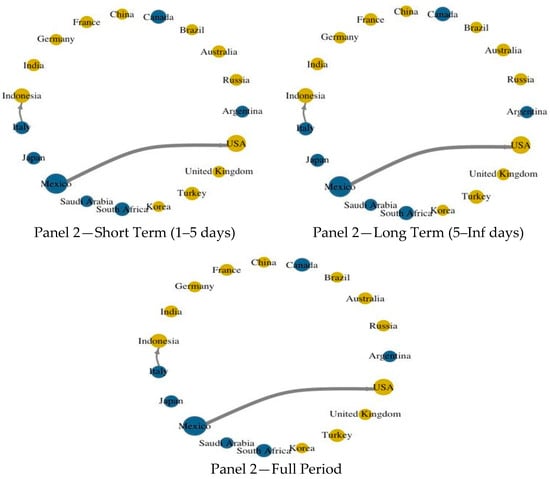
Figure 5.
Frequency spillover based on Barunik Krehlik (BK) during GFC 2008 in Short term (1–5), Long term (5–Inf), and Full period.
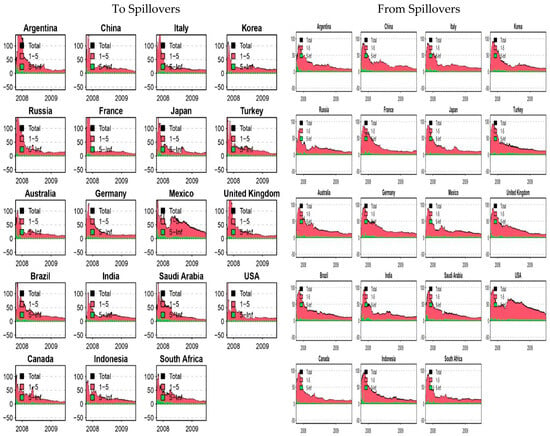
Figure 6.
Transmission of the volatility spillover “to spillover” (transmitter) and “from transmitter” (receiver) during the GFC, 2008. Total period represented by black, red color represents 1–5 days, and green color represents 5–Inf days (Panel 2).
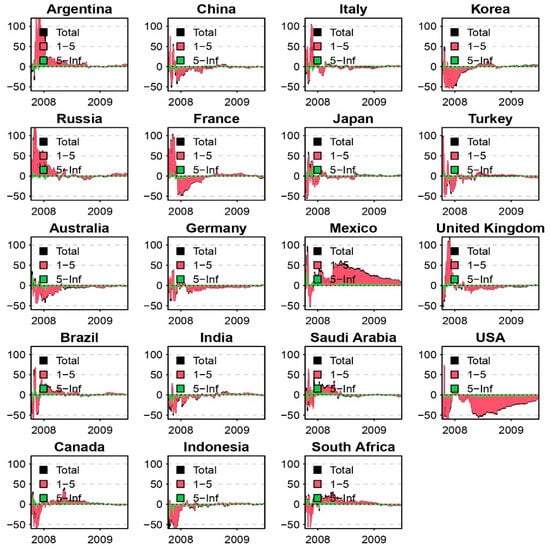
Figure 7.
Net spillover during GFC, 2008 (Panel 2).
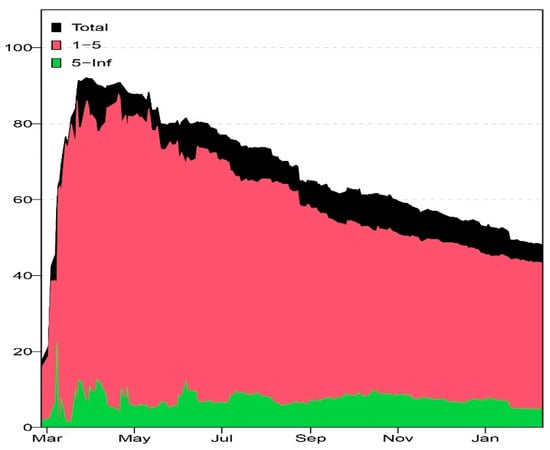
Figure 8.
Frequency spillover based on Barunik Krehlik (BK) during GFC, 2008, in short term (1–5), Long Term (5–Inf), and Full period (Panel 2).
Table 5 states the empirical results of volatility spillover between G20 nations during the COVID-19 pandemic using the TVP VAR BK methodology. Figure 9 shows the connectivity between the G20 nations across varied sub-periods, i.e., short-term, long-term, and full period. Figure 10 and Figure 11 show the “To, From, and net spillovers,” respectively. Figure 12 shows the TCI across varied frequencies. The findings reveal that the UK (25.11%), Russia (13.3%), Canada (9.4%), Argentina (6.63%), China (6.29%), Italy (2.9%), and Korea (1.3%) act as the net recipients of shocks during the COVID-19 pandemic across the varied frequencies. The UK and Canada are the major global financial hubs, and their exposure to extensive global trade amplified their shock reception during the pandemic (; ). Commodity-dependent economies such as Russia and Argentina faced dual shocks from induced demand contractions and oil price volatility, exacerbating their roles as net recipients (). Also, China’s manufacturing-centric economy suffered significant supply chain disruptions and export demand reduction, making it vulnerable to shocks during the pandemic (). However, Australia (2.08%), France (1.99%), Saudi Arabia (6.82%), South Africa (11.27%), and the USA (2.9%) emerged as the net transmitter of volatility spillover during the COVID-19 pandemic at both 1–5 (short term) and 5–Inf (long term) frequencies. The USA and Australia acted as volatility sources because of their central role in global capital flows and investor sentiment channels, whereas Saudi Arabia and South Africa amplified spillover via oil and mineral supply chains, thus transmitting volatility to other dependent markets (). Also, Brazil, France, India, Indonesia, Japan, and Turkey acted as a net transmitter of shocks in the short run, but they became net recipients of shocks in the long run. Initial pandemic shocks allowed these markets to transmit volatility via rapid sell-offs and currency fluctuations, whereas prolonged economic strain increased their susceptibility to external shocks, reversing their net position (; ). This implies that investors looking for long-run gains must look beyond these countries during the crisis period. Table 4 also reveals that the TCI was 33.85% in the short run (1–5), which reached 3.64% in the short run. It implies that short-term spikes reflected panic-driven contagion, where spillovers amplified over tightly linked markets, whereas long-term reduction signaled investor recalibration.

Table 5.
Barunik Krehlik (2018) returns spillover results for COVID-19.
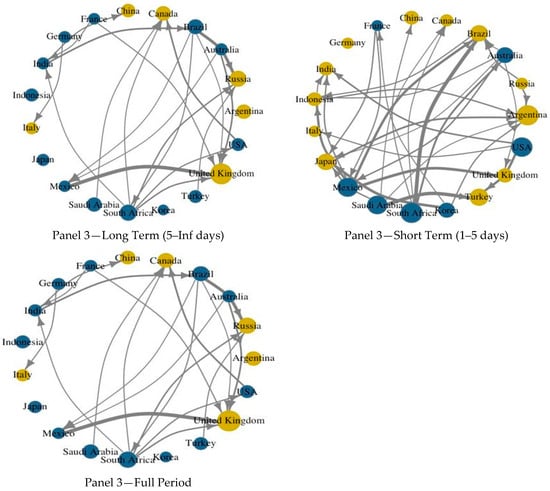
Figure 9.
Frequency spillover based on Barunik Krehlik (BK) during COVID-19 in Short term (1–5), Long term (5–Inf), and Full period.
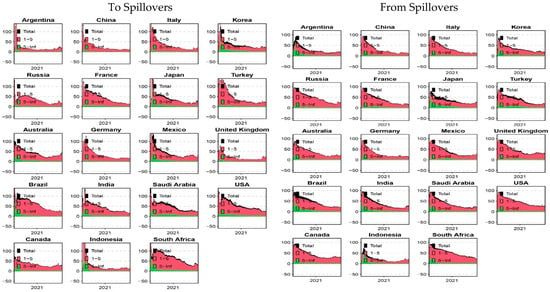
Figure 10.
Transmission of the volatility spillover “to spillover” (transmitter) and “from transmitter” (receiver) during COVID-19. Total period represented by black, red color represents 1–5 days, and green color represents 5–Inf (Panel 3).
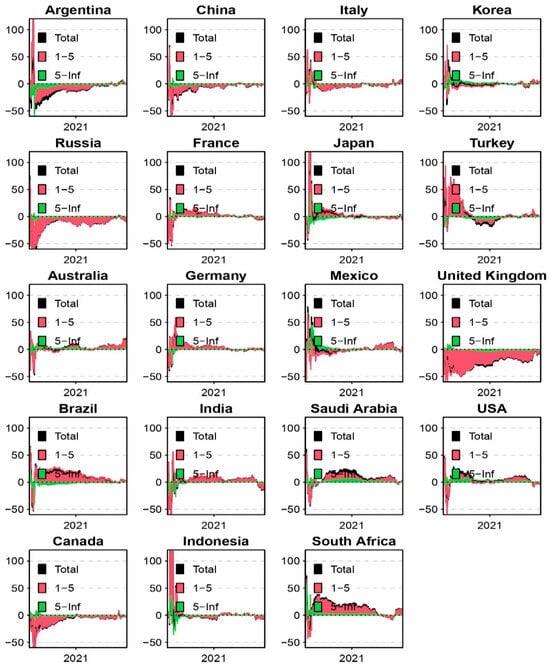
Figure 11.
Net spillover during GFC, 2008 (Panel 3).
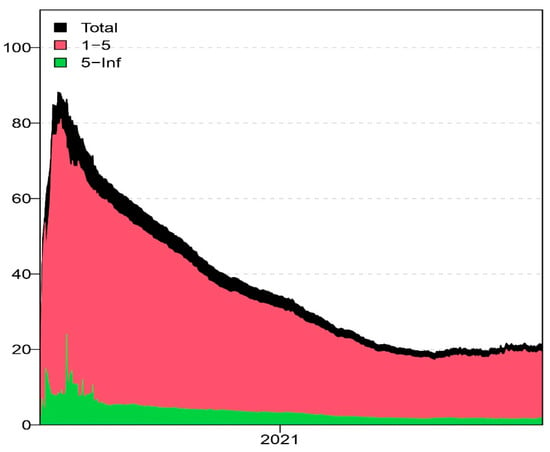
Figure 12.
Frequency spillover based on Barunik Krehlik (BK) during COVID-19 in the short term (1–5), Long Term (5–Inf), and Full period (Panel 3).
Table 6 reveals the empirical results of volatility spillover between G20 nations during the Russia-Ukraine crisis. Figure 13 shows the connectivity between the G20 nations across varied sub-periods, i.e., short-term, long-term, and full period. Figure 14 and Figure 15 show the “To, From, and net spillovers,” respectively. Figure 16 shows the TCI across varied frequencies. The findings of the TVP VAR BK model reveal that the USA (30.49%), Canada (25.81%), Argentina (23.79%), Brazil (17.04%), Indonesia (16.33%), Turkey (14.11), and France (10.72%) emerged as the net recipients of shocks during the Russia Ukraine crisis across the two frequency domains i.e., short term (1–5) and long term (5–Inf) both. US financial markets were significantly impacted by the external factors, and Canada, having close ties with the US, absorbed substantial volatility spillover during the crisis (). Argentina, Indonesia, and Brazil’s high percentage is due to their vulnerability to external shocks and the emerging market status (; ). Also, Turkey’s position as a net recipient is due to its economic vulnerability and geographic proximity to the conflict zone (). France, despite being a developed economy, absorbed significant shocks due to energy dependence and trade relations with the affected regions (). On the contrary, Japan (57.53%), Germany (31.83%), Mexico (22.72%), and Russia (27.73%) act as net transmitters of shocks across the varied sub-periods. Japan is a major importer of liquefied natural gas (LNG) and oil. The crisis and subsequent sanctions on Russia led to a sharp increase in global prices (). Thus, it transmits shocks to other G20 nations. Germany, Mexico, and Russia acted as net transmitters of shocks during the Russia-Ukraine crisis due to their central roles in global and regional trade, their importance in key sectors (energy, manufacturing, commodities), and the direct and indirect effects of war, sanctions, and supply disruptions on their economies and their trading partners in the G20 (). Moreover, the findings also reveal that in the short run, Australia, India, South Africa, and Turkey act as net recipients of shocks, whereas in the long run, these countries become net transmitters of shocks. In the short run, high external exposure, dominance of global markets, and limited immediate response made these countries vulnerable to the crisis (). Whereas, in the long run, economic growth and integration, feedback effects, and structural adjustments made these countries act as net transmitters of shocks (). Similarly, Italy and South Africa were the net transmitters of shocks in the short run. However, they became net recipient of shocks in the long run. Italy and South Africa initially amplified and transmitted shocks due to their economic structures and policy responses. Over time, however, their own vulnerabilities and the persistence of global instability made them more susceptible to external shocks, turning them into net recipients in the long run (). Furthermore, the results show the value of TCI, which reached 60.48% in the short run and 7.17% in the long run. The high short-term TCI value indicates the immediate and significant impact of the Russia-Ukraine crisis on global financial market interconnectedness. Long-term volatility patterns showed greater independence between markets.

Table 6.
Barunik Krehlik (2018) returns spillover results for the Russia-Ukraine Crisis.
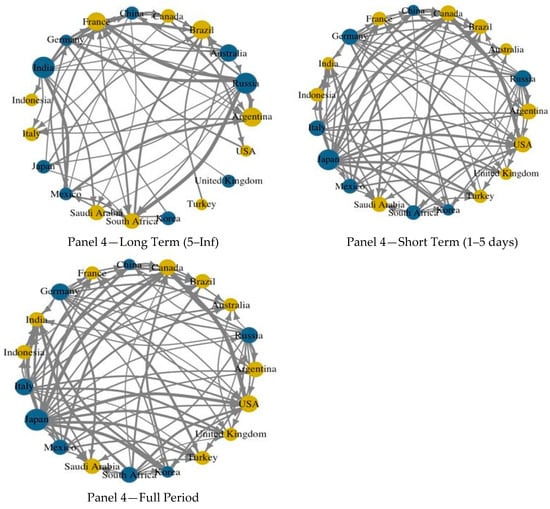
Figure 13.
Frequency spillover based on Barunik Krehlik (BK) during the Russia-Ukraine war in the Short term (1–5), Long term (5–Inf), and Full period.
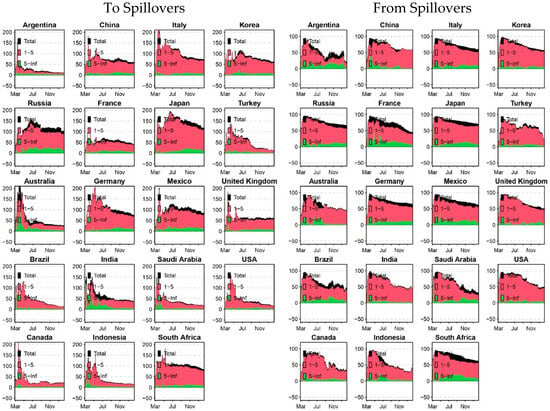
Figure 14.
Transmission of the volatility spillover “to spillover” (transmitter) and “from transmitter” (receiver) during the Russia-Ukraine War. Total period represented by black, red color represents 1–5 days, and green color represents 5–Inf days (Panel 4).
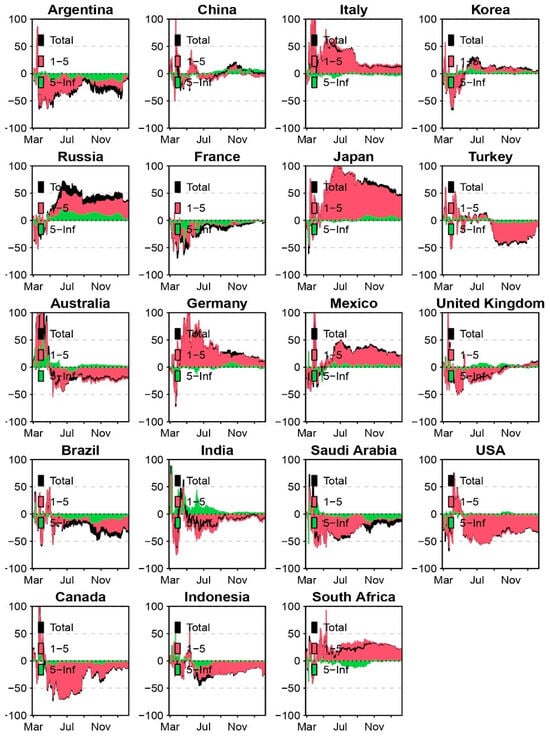
Figure 15.
Net spillover during the Russia-Ukraine War (Panel 4).
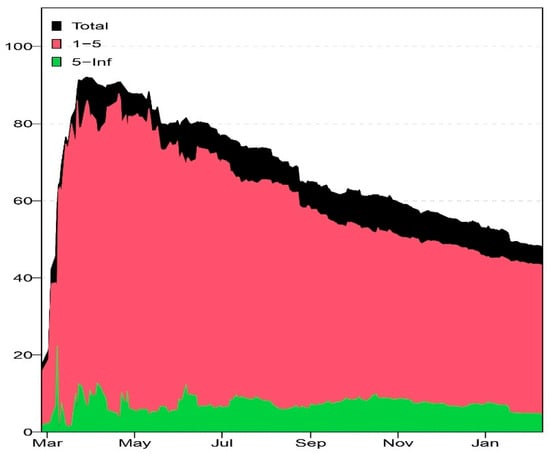
Figure 16.
Frequency spillover based on Barunik Krehlik (BK) during the Russia-Ukraine war in the short term (1–5), Long Term (5–Inf), and Full period (Panel 4).
Robustness Check
To evaluate the validity of our results, we conducted a robustness check on the spillover impact using various window widths. The research used three rolling window widths of 150, 200, and 250 for EDC, COVID-19, and GFC. Nevertheless, due to the shorter time frame, the rolling window widths for the Russia-Ukraine conflict were set at 100, 150, and 200. An analysis of the spillover curves shown in Figure 17 reveals that the general trend stays mostly uniform across different rolling window widths. This indicates that the duration of the window has little influence on the results derived from the empirical investigation. Moreover, the green line represents the TCI using 150 days window, the red line represents TCI using 250 days window, and black shaded area represents 200 days window. Similarly, during Russia Ukraine war the green line represents the TCI using 100 days window, the red line represents TCI using 200 days window, and black shaded area represents 150 days window.
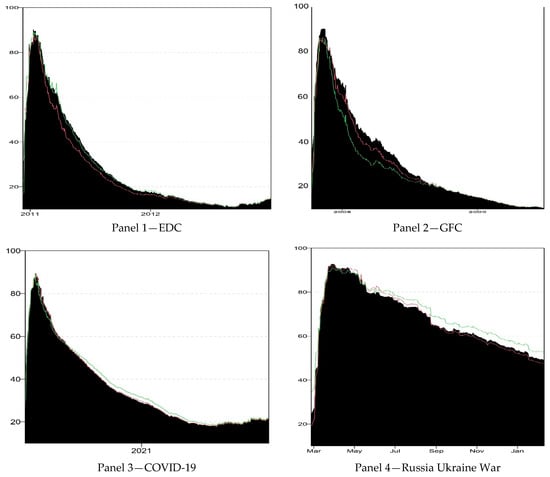
Figure 17.
Robustness of the results using different rolling window widths.
5. Conclusions
Our empirical TVP-VAR BK study reveals that volatility spillovers among G20 equity markets exhibited significant variation depending on the crisis episode. The TCI was mild in the GFC and EDC at approximately 25% in the near term, but increased to about 34% during COVID-19 and reached an extraordinary 60% during the Russia-Ukraine conflict. During the 2008-2009 Global Financial Crisis, the United States, as the epicenter, served as the primary transmitter of volatility, alongside other sources of disruption such as Mexico, Argentina, and South Africa, while major markets in North America, Asia, and Europe (e.g., Australia, China, India, Korea, France, Germany) predominantly absorbed the majority of the shocks. During the European Debt Crisis, spillovers were somewhat constrained: short-term net transmitters were Japan, Turkey, South Africa, and the United States, while emerging and developed markets, including Brazil, India, Australia, Germany, and the United Kingdom (along with Italy and Saudi Arabia in the long term), functioned as net receivers.
During the COVID-19 crisis, cross-market contagion escalated (TCI = 33.9%), with the UK, Russia, Canada, Argentina, China, and Italy experiencing significant volatility, while the US, Australia, Saudi Arabia, and South Africa functioned as net shock transmitters. Additionally, countries such as Brazil, India, and Turkey transitioned from short-run transmitters to long-run receivers as the pandemic progressed. The Russia-Ukraine war resulted in the highest level of interconnectedness, with Japan, Germany, Russia, and Mexico emerging as significant exporters of volatility, while the markets in the US, Canada, Brazil, Indonesia, Turkey, and France served as primary recipients. These findings demonstrate distinct crisis-specific patterns, ranging from the moderate, predominantly Europe-North America-centered spillovers in the EDC to the global, commodity-driven contagion resulting from the Russia-Ukraine war, and underscore the significant shifts in “transmission hub” countries and overall market integration (TCI) across crises. Thus, this study adds significantly to the literature on financial market volatility and contagion among G20 economies. It compares dynamic volatility spillovers across four major global crisis episodes, the global financial crisis of 2008, the European debt crisis, the COVID-19 pandemic, and the Russia-Ukraine war, using daily equity returns from all G20 stock markets. The use of advanced econometric techniques, specifically a time-varying parameter VAR (TVP-VAR) in conjunction with BK frequency domain decomposition, represents a methodological advancement that enables a nuanced investigation of both short-term (1–5 days) and long-term (5–Inf days) spillover effects.
The research has several limitations with the study, like the fact that it only uses data from the stock market, daily frequency returns, and summed crisis period windows. These might make it harder to understand how transmission mechanisms work at the sector or high-frequency level. The study also doesn’t look at exogenous factors like policy announcements, macroeconomic shocks, or sentiment data, which could help us understand what causes short- and long-term spillovers better. As our study is mostly about the frequency-based BK spillover index and TVP VAR, future research can focus on new and advanced models such as neural networks, Markov switching copula contagion, and mixed-frequency deep learning. These models may help us understand nonlinear dynamics and regime-dependent contagion patterns better.
6. Implications
This study’s findings have important implications for policymakers, institutional investors, and financial regulators in a global financial environment that is becoming increasingly interconnected. The significant volatility spillovers noted during crises, particularly the Russia-Ukraine conflict and COVID-19, highlight the necessity for ongoing systemic risk monitoring and responsive policy coordination among G20 economies. The spike in the TCI during geopolitical and health-related shocks suggests that conventional static models may undervalue the extent of financial contagion, especially in short-term contexts. Regulators in emerging economies like Turkey, South Africa, and India, which often experience volatility, must prioritize the development of responsive macroprudential tools, the implementation of robust financial safety nets, and vigilant monitoring of capital flow dynamics. Portfolio managers and risk officers must acknowledge the significance of short-term spillovers and implement dynamic hedging and diversification strategies that account for both temporal and frequency aspects of volatility transmission. The study recommends incorporating time-frequency spillover models, such as TVP VAR BK, into central bank stress-testing frameworks to enhance the anticipation and response to crisis propagation. Finally, the uneven roles of nations, with developed markets frequently serving as reliable transmitters, highlight the need for global financial governance mechanisms to reduce shock diffusion and safeguard systemically vulnerable markets.
Author Contributions
Conceptualization, H.G., P.B., M.A., A.A., and S.D.; Methodology, H.G., and P.B.; Software, P.B.; Validation, H.G., and P.B.; Formal Analysis, H.G., P.B., M.A., A.A., and S.D.; Investigation, H.G., and P.B.; Resources, A.A., and S.D.; Data Curation, H.G., P.B., and M.A.; Writing—Original Draft Preparation, H.G., P.B., M.A., A.A., and S.D.; Visualization, P.B.; Supervision, H.G., P.B., A.A., and S.D.; Project Administration, H.G., P.B., M.A., A.A., and S.D.; Funding Acquisition, A.A., and S.D. All authors have read and agreed to the published version of the manuscript.
Funding
This research received no external funding.
Institutional Review Board Statement
Not applicable.
Informed Consent Statement
Not applicable.
Data Availability Statement
Data is accessible in the public domain.
Conflicts of Interest
The authors declare no conflicts of interest.
Abbreviations
The following abbreviations are used in this manuscript:
| TVP-VAR | time-varying parameter vector autoregression |
| TCI | total connectedness index |
| BK | Baruník-Křehlík |
| GFC | Global Financial Crisis |
| EDC | European Debt Crisis |
| GDP | Gross Domestic Production |
| CDS | Credit Default Swap |
| US | United States |
| VIX | Volatility Index |
| GFEVD | generalized forecast error variance decomposition |
| VMA | vector moving average |
| USA | United States of America |
| UK | United Kingdom |
| LNG | liquified natural gas |
References
- Acharya, V. V., & Richardson, M. P. (Eds.). (2009). Restoring financial stability: How to repair a failed system. John Wiley & Sons. [Google Scholar]
- Ahmed Memon, B., Aslam, F., Naveed, H. M., Ferreira, P., & Ganiev, O. (2024). Influence of the Russia–Ukraine War and COVID-19 pandemic on the efficiency and herding behavior of stock markets: Evidence from G20 nations. Economies, 12(5), 106. [Google Scholar] [CrossRef]
- Aizenman, J., Hutchison, M., & Jinjarak, Y. (2013). What is the risk of European sovereign debt defaults? Fiscal space, CDS spreads and market pricing of risk. Journal of International Money and Finance, 34, 37–59. [Google Scholar] [CrossRef]
- Akbulut, N., Aktürk, B., & Ari, Y. (2024). TVP-VAR frequency connectedness analysis on CPI-based monthly real return volatility of financial investment instruments. Ekonomski vjesnik/Econviews-Review of Contemporary Business, Entrepreneurship and Economic Issues, 37(2), 319–337. [Google Scholar] [CrossRef]
- Akca, K., & Ozturk, S. S. (2016). The effect of 2008 crisis on the volatility spillovers among six major markets. International Review of Finance, 16(1), 169–178. [Google Scholar] [CrossRef]
- Albulescu, C. T. (2020). Coronavirus and financial volatility: 40 days of fasting and fear. Research in International Business and Finance, 54, 101326. [Google Scholar] [CrossRef]
- Altınkeski, B. K. (2023). Geopolitical risk spillovers: Evidence from G20 countries. Journal of Economics and Political Sciences, 3(2), 64–77. [Google Scholar]
- Anand K, K., & Mishra, A. K. (2023). Market connectedness and volatility spillovers: A meta-literature review. Commodities, 2(3), 201–219. [Google Scholar] [CrossRef]
- Antonakakis, N., & Gabauer, D. (2017). Refined measures of dynamic connectedness based on TVP-VAR (MPRA Paper No. 78282). Available online: https://mpra.ub.uni-muenchen.de/78282/ (accessed on 15 September 2025).
- Antonakakis, N., Gabauer, D., Gupta, R., & Plakandaras, V. (2018). Dynamic connectedness of uncertainty across developed economies: A time-varying approach. Economics Letters, 166, 63–75. [Google Scholar] [CrossRef]
- Ashraf, B. N. (2020). Economic impact of government interventions during the COVID-19 pandemic: International evidence from financial markets. Journal of Behavioral and Experimental Finance, 27, 100371. [Google Scholar] [CrossRef]
- Attílio, L. A. (2024). Transmission and impact of stock market shocks on the world economy. Central Bank Review, 24(1), 100149. [Google Scholar] [CrossRef]
- Baker, S. R., Bloom, N., Davis, S. J., & Terry, S. J. (2020). COVID-induced economic uncertainty (NBER Working Paper No. 26983). Available online: http://www.nber.org/papers/w26983 (accessed on 15 September 2025).
- Baruník, J., Kočenda, E., & Vácha, L. (2016). Gold, oil, and stocks: Dynamic correlations. International Review of Economics & Finance, 42, 186–201. [Google Scholar] [CrossRef]
- Baruník, J., & Křehlík, T. (2018). Measuring the frequency dynamics of financial connectedness and systemic risk. Journal of Financial Econometrics, 16(2), 271–296. [Google Scholar] [CrossRef]
- Beirne, J., & Fratzscher, M. (2013). The pricing of sovereign risk and contagion during the European sovereign debt crisis. Journal of International Money and Finance, 34, 60–82. [Google Scholar] [CrossRef]
- Borri, N., & Shakhnov, K. (2020). Regulation spillovers across cryptocurrency markets. Finance Research Letters, 36, 101333. [Google Scholar] [CrossRef]
- Brunnermeier, M. K. (2009). Deciphering the liquidity and credit crunch 2007–2008. Journal of Economic perspectives, 23(1), 77–100. [Google Scholar] [CrossRef]
- Cheema, M. A., Faff, R., & Szulczyk, K. R. (2022). The 2008 global financial crisis and COVID-19 pandemic: How safe are the safe haven assets? International Review of Financial Analysis, 83, 102316. [Google Scholar] [CrossRef]
- Chen, P., & Semmler, W. (2018). Financial stress, regime switching and spillover effects: Evidence from a multi-regime global VAR model. Journal of Economic Dynamics and Control, 91, 318–348. [Google Scholar] [CrossRef]
- Chen, W. P., Wu, C. C., & Aimable, W. (2025). Cryptocurrency market spillover in times of uncertainty. The North American Journal of Economics and Finance, 76, 102347. [Google Scholar] [CrossRef]
- Copeland, M., Copeland, T., & Copeland, T. (2017). Revising equity valuation with tail risk. Journal of Portfolio Management, 43(4), 100. [Google Scholar] [CrossRef]
- Das, R., & Debnath, A. (2022). Analyzing the COVID-19 pandemic volatility spillover influence on the collaboration of foreign and Indian stock markets. Revista Finanzas y Política Económica, 14(2), 411–452. [Google Scholar] [CrossRef]
- Diebold, F. X., & Yilmaz, K. (2009). Measuring financial asset return and volatility spillovers, with application to global equity markets. The Economic Journal, 119(534), 158–171. [Google Scholar] [CrossRef]
- Diebold, F. X., & Yilmaz, K. (2012). Better to give than to receive: Predictive directional measurement of volatility spillovers. International Journal of Forecasting, 28(1), 57–66. [Google Scholar] [CrossRef]
- Diebold, F. X., & Yilmaz, K. (2014). On the network topology of variance decompositions: Measuring the connectedness of financial firms. Journal of Econometrics, 182(1), 119–134. [Google Scholar] [CrossRef]
- Dsouza, S., Singh, N. P., & Oliyide, J. A. (2024). Dynamic connectedness among the BRICS markets and the recent pandemic: An application of TVP-VAR approach. International Journal of Emerging Markets, 20(9), 3721–3743. [Google Scholar] [CrossRef]
- Dufrénot, G., & Keddad, B. (2014). Spillover effects of the 2008 global financial crisis on the volatility of the Indian equity markets: Coupling or uncoupling? A study on sector-based data. International Review of Financial Analysis, 33, 17–32. [Google Scholar] [CrossRef]
- Ehrmann, M., Fratzscher, M., Mehl, A., & Bekaert, G. (2011). Global crises and equity market contagion (No. 1381). Available online: https://www.ecb.europa.eu/pub/pdf/scpwps/ecbwp1381.pdf (accessed on 1 September 2025).
- Engle, R. F., Gallo, G. M., & Velucchi, M. (2012a). Volatility spillovers in East Asian financial markets: A MEM-based approach. Review of Economics and Statistics, 94(1), 222–223. [Google Scholar] [CrossRef]
- Engle, R. F., Ghysels, E., & Sohn, B. (2012b). Stock market volatility and macroeconomic fundamentals. The Review of Economics and Statistics, 95(3), 776–797. [Google Scholar] [CrossRef]
- Fernandes, N. (2020). Economic effects of coronavirus outbreak (COVID-19) on the world economy (IESE Business School Working Paper No. WP-1240-E). Available online: https://ssrn.com/abstract=3557504 (accessed on 15 September 2025).
- Ferrer, R., Shahzad, S. J. H., López, R., & Jareño, F. (2018). Time and frequency dynamics of connectedness between renewable energy stocks and crude oil prices. Energy Economics, 76, 1–20. [Google Scholar] [CrossRef]
- Fitzgerald, D. A., & Wong, G. W. (2020). COVID-19: A tale of two pandemics across the Asia Pacific region. Paediatric Respiratory Reviews, 35, 75–80. [Google Scholar] [CrossRef]
- Forbes, K. J., & Rigobon, R. (2002). No contagion, only interdependence: Measuring stock market comovements. The Journal of Finance, 57(5), 2223–2261. [Google Scholar] [CrossRef]
- Gallo, G. M., & Otranto, E. (2008). Volatility spillovers, interdependence and comovements: A Markov Switching approach. Computational Statistics & Data Analysis, 52(6), 3011–3026. [Google Scholar] [CrossRef]
- Giangrande, N. (2023). The consequences of the Russian-Ukrainian war on the Italian economy and the need for a ‘full and good employment’ strategy. PSL Quarterly Review, 76(306), 277–291. [Google Scholar]
- Goodell, J. W. (2020). COVID-19 and finance: Agendas for future research. Finance Research Letters, 35, 101512. [Google Scholar] [CrossRef]
- Guru, B. K., & Yadav, I. S. (2023). Stock market integration and volatility spillovers: New evidence from Asia–Pacific and European markets. The Journal of Risk Finance, 24(2), 186–211. [Google Scholar] [CrossRef]
- He, Q., Liu, J., Wang, S., & Yu, J. (2020). The impact of COVID-19 on stock markets. Economic and Political Studies, 8(3), 275–288. [Google Scholar] [CrossRef]
- Hendy, P., & Beckers, B. (2024). How do global shocks affect Australia? RBA Research Discussion Papers. Reserve Bank of Australia. [Google Scholar] [CrossRef]
- Hossain, A. T., Masum, A. A., & Saadi, S. (2024). The impact of geopolitical risks on foreign exchange markets: Evidence from the Russia–Ukraine war. Finance Research Letters, 59, 104750. [Google Scholar] [CrossRef]
- Huang, J., Chen, B., Xu, Y., & Xia, X. (2023). Time-frequency volatility transmission among energy commodities and financial markets during the COVID-19 pandemic: A Novel TVP-VAR frequency connectedness approach. Finance Research Letters, 53, 103634. [Google Scholar] [CrossRef]
- IMF. (2020). World economic outlook: A long and difficult ascent. International Monetary Fund. [Google Scholar]
- James, H. (2024). The IMF and the European debt crisis. International Monetary Fund. [Google Scholar]
- Janakiramanan, S., & Lamba, A. S. (2000, May 14–16). Capital market integration and information transmission among equity markets. PACP/FMA Conference, Melbourne, Australia. [Google Scholar]
- Jebabli, I., Kouaissah, N., & Arouri, M. (2022). Volatility spillovers between stock and energy markets during crises: A comparative assessment between the 2008 global financial crisis and the COVID-19 pandemic crisis. Finance Research Letters, 46, 102363. [Google Scholar] [CrossRef]
- Jena, S. K., Tiwari, A. K., Dash, A., & Aikins Abakah, E. J. (2021). Volatility spillover dynamics between large-, mid-, and small-cap stocks in the time-frequency domain: Implications for portfolio management. Journal of Risk and Financial Management, 14(11), 531. [Google Scholar] [CrossRef]
- Johansson, A. C., & Ljungwall, C. (2009). Spillover effects among the Greater China stock markets. World Development, 37(4), 839–851. [Google Scholar] [CrossRef]
- Kakran, S., Kumari, V., Bajaj, P. K., & Sidhu, A. (2024). Exploring crisis-driven return spillovers in APEC stock markets: A frequency dynamics analysis. The Journal of Economic Asymmetries, 29, e00342. [Google Scholar] [CrossRef]
- Kaminsky, G. L., & Reinhart, C. M. (1998). Financial crises in Asia and Latin America: Then and now. The American Economic Review, 88(2), 444–448. [Google Scholar]
- Kaminsky, G. L., & Reinhart, C. M. (2000). On crises, contagion, and confusion. Journal of International Economics, 51(1), 145–168. [Google Scholar] [CrossRef]
- Karkowska, R., & Urjasz, S. (2025). How does the volatility of ESG stock indices spillover in times of high geopolitical risk? New insights from emerging and developed markets. Journal of Sustainable Finance & Investment, 15(3), 77–623. [Google Scholar] [CrossRef]
- Kodres, L. E., & Pritsker, M. (2002). A rational expectations model of financial contagion. The Journal of Finance, 57(2), 769–799. [Google Scholar] [CrossRef]
- Korkusuz, B., McMillan, D. G., & Kambouroudis, D. (2023). Complex network analysis of volatility spillovers between global financial indicators and G20 stock markets. Empirical Economics, 64(4), 1517–1537. [Google Scholar] [CrossRef]
- Kubitza, C. (2021). Tackling the volatility paradox: Spillover persistence and systemic risk (No. 079). ECONtribute Discussion Paper. ECONtribute. [Google Scholar]
- Lane, P. R. (2012). The European sovereign debt crisis. Journal of Economic Perspectives, 26(3), 49–68. [Google Scholar] [CrossRef]
- Li, Y., & Giles, D. E. (2015). Modelling volatility spillover effects between developed stock markets and Asian emerging stock markets. International Journal of Finance & Economics, 20(2), 155–177. [Google Scholar]
- Li, Y., Zhuang, X., Wang, J., & Dong, Z. (2021). Analysis of the impact of COVID-19 pandemic on G20 stock markets. The North American Journal of Economics and Finance, 58, 101530. [Google Scholar] [CrossRef]
- Liu, H., Manzoor, A., Wang, C., Zhang, L., & Manzoor, Z. (2020). The COVID-19 outbreak and affected countries’ stock markets response. International Journal of Environmental Research and Public Health, 17(8), 2800. [Google Scholar] [CrossRef] [PubMed]
- Liu, T., & Gong, X. (2020). Analyzing time-varying volatility spillovers between the crude oil markets using a new method. Energy Economics, 87, 104711. [Google Scholar] [CrossRef]
- Longstaff, F. A. (2010). The subprime credit crisis and contagion in financial markets. Journal of Financial Economics, 97(3), 436–450. [Google Scholar] [CrossRef]
- Maghyereh, A. I., Abdoh, H., & Awartani, B. (2019). Connectedness and hedging between gold and Islamic securities: A new evidence from time-frequency domain approaches. Pacific-Basin Finance Journal, 54, 13–28. [Google Scholar] [CrossRef]
- Mi, J. J., Ahmed, S., & Chen, Y. (2025). Exploring volatility transmission in Capesize freight contracts: Insights from energy and commodity markets. PLoS ONE, 20(1), e0317487. [Google Scholar] [CrossRef]
- Müller, U. A., Dacorogna, M. M., Davé, R. D., Olsen, R. B., Pictet, O. V., & Von Weizsäcker, J. E. (1997). Volatilities of different time resolutions—Analyzing the dynamics of market components. Journal of Empirical Finance, 4(2–3), 213–239. [Google Scholar] [CrossRef]
- Naeem, M. A., Hamouda, F., Karim, S., & Vigne, S. A. (2023). Return and volatility spillovers among global assets: Comparing health crisis with geopolitical crisis. International Review of Economics & Finance, 87, 557–575. [Google Scholar] [CrossRef]
- Naeem, M. A., Qureshi, F., Farid, S., Tiwari, A. K., & Elheddad, M. (2024). Time-frequency information transmission among financial markets: Evidence from implied volatility. Annals of Operations Research, 334(1), 701–729. [Google Scholar] [CrossRef]
- Narayan, P. K. (2020). Oil price news and COVID-19—Is there any connection? Energy Research Letters, 1(1), 13176. [Google Scholar] [CrossRef]
- Nghi, L. D., & Kieu, N. M. (2021). Volatility spillover from the united states and Japanese stock markets to the Vietnamese stock market: A frequency domain approach. Panoeconomicus, 68(1), 35–52. [Google Scholar] [CrossRef]
- Padmasree, K. (2023). Dynamics of volatility spillover and connectedness among sectors of Indian stock market. IUP Journal of Applied Finance, 29(1), 5–31. [Google Scholar]
- Pesaran, M. H., Schuermann, T., & Weiner, S. M. (2004). Modeling regional interdependencies using a global error-correcting macroeconometric model. Journal of Business & Economic Statistics, 22(2), 129–162. [Google Scholar] [CrossRef]
- Pohlkamp, E. (2023, February 21). Tokyo drift: War in Europe and Japan’s shifting strategy. ECFR. Available online: https://ecfr.eu/article/tokyo-drift-war-in-europe-and-japans-shifting-strategy/ (accessed on 25 August 2025).
- Reinhart, C. M., & Rogoff, K. S. (2009). This time is different: Eight centuries of financial folly. Princeton University Press. [Google Scholar]
- Sharif, A., Aloui, C., & Yarovaya, L. (2020). COVID-19 pandemic, oil prices, stock market, geopolitical risk, and policy uncertainty nexus in the US economy: Fresh evidence from the wavelet-based approach. International Review of Financial Analysis, 70, 101496. [Google Scholar] [CrossRef]
- Shu, M., Liu, B., Wang, J., & Huang, Y. (2025). How climate shocks affect stock market risk spillovers: Evidence from causal forest algorithm. Computational Economics, 66(5), 4417–4449. [Google Scholar] [CrossRef]
- Tiwari, A. K., Cunado, J., Gupta, R., & Wohar, M. E. (2018). Volatility spillovers across global asset classes: Evidence from time and frequency domains. The Quarterly Review of Economics and Finance, 70, 194–202. [Google Scholar] [CrossRef]
- Tsai, I. C. (2014). Spillover of fear: Evidence from the stock markets of five developed countries. International Review of Financial Analysis, 33, 281–288. [Google Scholar] [CrossRef]
- Vladimirov, M., Stefanov, R., & Koppen, M. (2023, September 5). Study: Phasing out Russian economic influence in Germany. Friedrich Naumann Foundation. Available online: https://www.freiheit.org/strategic-decoupling-phasing-out-russian-economic-influence-germany (accessed on 30 August 2025).
- Wang, B., & Xiao, Y. (2023). Risk spillovers from China’s and the US stock markets during high-volatility periods: Evidence from East Asianstock markets. International Review of Financial Analysis, 86, 102538. [Google Scholar] [CrossRef]
- Wang, J., Wang, J., & Ma, F. (2024). International commodity market and stock volatility predictability: Evidence from G7 countries. International Review of Economics & Finance, 90, 62–71. [Google Scholar]
- World Bank. (2021). Global economic prospects. World Bank. [Google Scholar]
- Xiang, L., Ma, S., Yu, L., Wang, W., & Yin, Z. (2022). Modeling the global dynamic contagion of COVID-19. Frontiers in Public Health, 9, 809987. [Google Scholar] [CrossRef]
- Xiao, Y., Dong, Z., Huang, S., Li, Y., Wang, J., & Zhuang, X. (2023). Time--Frequency Volatility Spillovers among Major International Financial Markets: Perspective from Global Extreme Events. Discrete Dynamics in Nature and Society, 2023(1), 7200306. [Google Scholar] [CrossRef]
- Xue, J. Y., Hsiao, C. Y. L., Li, P., & Chui, C. M. (2024). Higher-order contagion effects in Russian fuel export markets: Evidence from COVID-19 pandemic and Russia-Ukraine war. Energy Strategy Reviews, 53, 101419. [Google Scholar] [CrossRef]
- Yang, Y., Zhao, L., Zhu, Y., Chen, L., Wang, G., & Wang, C. (2023). Spillovers from the Russia-Ukraine conflict. Research in International Business and Finance, 66, 102006. [Google Scholar] [CrossRef]
- Yarovaya, L., Brzeszczyński, J., Goodell, J. W., Lucey, B., & Lau, C. K. M. (2022). Rethinking financial contagion: Information transmission mechanism during the COVID-19 pandemic. Journal of International Financial Markets, Institutions and Money, 79, 101589. [Google Scholar] [CrossRef]
- Yi, S., Xu, Z., & Wang, G. J. (2018). Volatility connectedness in the cryptocurrency market: Is Bitcoin a dominant cryptocurrency? International Review of Financial Analysis, 60, 98–114. [Google Scholar] [CrossRef]
- Yousaf, I., Patel, R., & Yarovaya, L. (2022). The reaction of G20+ stock markets to the Russia–Ukraine conflict “black-swan” event: Evidence from event study approach. Journal of Behavioral and Experimental Finance, 35, 100723. [Google Scholar] [CrossRef]
- Yousef, I. (2020). Spillover of COVID-19: Impact on stock market volatility. International Journal of Psychosocial Rehabilitation, 24(6), 18069–18081. [Google Scholar]
- Yu, H., Chu, W., Ding, Y. A., & Zhao, X. (2021). Risk contagion of global stock markets under COVID-19: A network connectedness method. Accounting & Finance, 61(4), 5745–5782. [Google Scholar]
- Zaremba, A., Kizys, R., Aharon, D. Y., & Demir, E. (2020). Infected markets: Novel coronavirus, government interventions, and stock return volatility around the globe. Finance Research Letters, 35, 101597. [Google Scholar] [CrossRef]
- Zhang, D., & Broadstock, D. C. (2020). Global financial crisis and rising connectedness in the international commodity markets. International Review of Financial Analysis, 68, 101239. [Google Scholar] [CrossRef]
- Zhang, D., Hu, M., & Ji, Q. (2020). Financial markets under the global pandemic of COVID-19. Finance Research Letters, 36, 101528. [Google Scholar] [CrossRef]
- Zhang, L., Liang, C., Huynh, L. D. T., Wang, L., & Damette, O. (2024). Measuring the impact of climate risk on renewable energy stock volatility: A case study of G20 economies. Journal of Economic Behavior & Organization, 223, 168–184. [Google Scholar] [CrossRef]
- Zhao, L., He, W., Wang, A., & Zhu, F. (2023). Time and frequency spillovers between the green economy and traditional energy markets. Systems, 11(3), 153. [Google Scholar] [CrossRef]
Disclaimer/Publisher’s Note: The statements, opinions and data contained in all publications are solely those of the individual author(s) and contributor(s) and not of MDPI and/or the editor(s). MDPI and/or the editor(s) disclaim responsibility for any injury to people or property resulting from any ideas, methods, instructions or products referred to in the content. |
© 2025 by the authors. Licensee MDPI, Basel, Switzerland. This article is an open access article distributed under the terms and conditions of the Creative Commons Attribution (CC BY) license (https://creativecommons.org/licenses/by/4.0/).